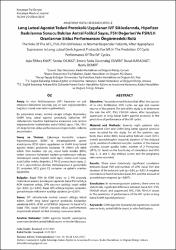Long luteal agonist tedavi protokolü uygulanan IVF sikluslarında, hipofizer baskılanma sonucu bakılan antral folikül sayısı, FSH değerleri ve FSH/LH oranlarının siklus performansını öngörmedeki rolü
Özet
Amaç: In vitro fertilizasyonun (IVF) başarısını en çok
etkileyen faktörlerin başında; yaş ve tüm değişkenlerden
bağımsız olarak over rezervi gelmektedir.
Bu çalışmanın amacı; normal cevaplı olduğu düşünülen,
GnRH long luteal agonist protokolü kullanılan IVF
sikluslarında hipofizer baskılanma esnasında over rezervi
değerlendirme testlerinden antral folikül sayısı, FSH, FSH/
LH değerlerinin siklus performansını öngörmedeki rollerini
araştırmaktır.
Gereç ve Yöntem: Çalışmaya kontrollü ovaryen
hiperstimülasyon (KOH) ve intrasitoplazmik sperm
enjeksiyonu (ICSI) işlemi uygulanan ve GnRH long luteal
agonist tedavi protokolü başlanan 78 infertil çift dahil
edildi. Tüm hastalar için yaş, vücut kütle indeksi (BMİ),
tedavi süresince kullanılan toplam gonadotropin miktarı,
stimülasyon süresi, toplam oosit sayısı, matür oosit sayısı,
oosit kalite indeks değerleri, 2 PN (2 pronucleus) sayısı, 2.
3. ve 5. gün embriyo skorları, stimülasyonun 4. günündeki
E2 seviyeleri, HCG günü E2 seviyeleri ve gebelik oranları
kaydedildi.
Bulgular: Bazal FSH ile KOH süresi ve 2 PN arasında
istatistiksel anlamlı korelasyon saptandı. Bazal FSH arttıkça
KOH süresinin arttığı, 2PN sayısının azaldığı tespit edildi
[(p= 0,04), (p= 0,01)]. Bazal AFS arttıkça toplam kullanılan
gonadotropin miktarının azaldığı saptandı (p= 0,007).
Sonuç: IVF sikluslarında normal cevaplı olduğu kabul
edilen, GnRH long luteal agonist protokolü başlanılan
vakalarda bAFS, bFSH ve bFSH/LH değerleri ile bazal AFS;
bazal FSH, bazal FSH/LH arasında siklus performansını
öngörmede anlamlı bir fark olmadığı sonucuna varıldı. Objective: The predominant factors that affect the success
of in vitro fertilization (IVF) cycles are age and ovarian
reserve of the patient. The aim of this study is; to determine
the role the AFC, FSH, FSH/LH values, after hypophysis
supression in long luteal GnRH agonist protocol, in the
prediction of performance of the IVF cycles.
Material and Methods: Seventy eight patients who
underwent COH and GnRH long luteal agonist protocol
were recruited for the study. For all the patients; age,
body mass index (BMI), basal antral follicule count (AFC),
overall gonadotrophin required, duration of the induced
cycle, number of collected oocytes, number of the mature
oocytes, oocyte quality index, number of 2 Pronucleus
(2PN), E2 levels on the fourth day of stimulation and HCG
day, 2., 3. and 5. day embryo scores and the pregnancy
rates were recorded.
Results: There were statistically significant correlation
between basal FSH and number of 2PN; basal FSH and
duration of the induced cycle (p= 0,04, p= 0,01). A negative
correlation is found between basal AFC and the amount of
gonadotropin required (p= 0,007).
Conclusion: In normoresponsive patients, there were no
statistically significant difference between basal AFC, FSH,
FSH/LH values and suppressed AFC, FSH, FSH/LH values
in the prediction of performance of the IVF cycles in long
luteal GnRH Agonist protocol.
Kaynak
Afyon Kocatepe Üniversitesi, Kocatepe Tıp DergisiCilt
16Sayı
4Bağlantı
http://hdl.handle.net/11630/4162Koleksiyonlar
- Kocatepe Tıp Dergisi [154]



















